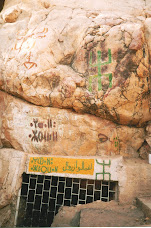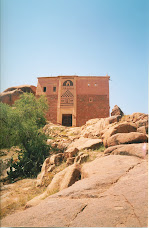“The Memoir of a Berber by: Hassan Ouakrim”
A Reflective study of the book
By: Hassane Oudadene
One of the most prominent things in the life of any human being is the mind, not only the stomach. If food is so crucial for the stomach to live on, intellect is a very necessary ingredient for the mind to survive. To fulfill this feeding potential, reading is deemed as part and parcel of any individual’s duty and not only for intellectuals. More important, however, is the sweet feelings the reader is kindled with when criticizing a piece of literature for the simple reason that critical thinking and reflective analysis, so long as they are constructive, generate more often reconstruction, reform and conformity rather than conflict and bias.
In this respect, I feel that it is incumbent on me to put this theory into practice and try to draw a personal reflection on a piece of literature that I have gone over more than once. In fact, I have found my great pleasure to read, discuss and pierce into the fabric of this wonderful work signed by a dearest Berber friend, a a self-taught man man who managed to go up the social ladder through intellect and the course of a bittersweet fate. Through this memoir, Mr. Larsen krim has taken my memory back to assorted eras in Moroccan history. He has been so eloquent speaking out a personal experience which could be described, along the writer’s life stages, as both merry and melancholic. An experience featured with particular snapshots evoking certain characteristics of the Moroccan political, and particularly cultural history. Besides, through Mr. Krim’s paper, one could learn a great deal about the discrepancy between the North of Morocco as a productive and promissory part of the land contrary to the Southern part being a single isolated land deserted by a huge number of citizens for the sake of survival. Mr Lahcen, recognized more by Hassan in his hometown, was one of these citizens as well. Further, the beautifully well formed story of Lahcen has revealed even top secret occurrences about the institution of his family throughout his endeavor. Some reviewers may consider this family, upon reading this work, as being dysfunctional. However, others may view the relationship between the family members as part of a pure nature of kinship in Morocco.
More remarkable is the fact that the autobiography has really been compiled in a smoothly chronological sequence that takes the reader’s imagination away into a fictional world where they could understand that the protagonist managed to move to unknown planet, and he, accordingly, achieved one of the best goals in his life by winning the last ticket to the land of dreams, the promising world, a land viewed as paradise by utopian people. Lahcen Wakrim managed to meet his aims by being, eventually, one of the successful episodes of a famous tale called “The American Dream”. The generous land of The States has, not only, made him attain his goals in the domain of Art, but also changed him into an intellectual man whose character was much influenced by America and whose thirst for art and intellect has been satiated. Mr. Lahcen Wakrim has been in a deep coherence and compatibility with the promising land of America to the extent that his Arabic name Lahcen Wakrim was officially changed into Larsen Krim to sound more American.
Moving to America for Larsen was not only a success but a triumph as well. An achievement which was touched no matter how the impediments had been. In fact, the events of this story reveal that his success was partly thanks to the help of destiny and partly thanks to the deep belief and conviction in the open way paved by his strong will. The 60’s in Morocco witnessed the North to be of a valuable world status, particularly Tangier, the famous Northern city bordered by both the Atlantic on the west and the Mediterranean on the North. This town had been declared as an international zone that provided job accessibility to citizens coming from different parts of the country, a comfortable shelter to famous Western VIPs to settle down, and more specifically, it provided a passage bridge issuing visas to people who viewed the grass greener on the other side of the fence. In fact, Lahcen was one of the beneficiaries and his good fate was the fact that his father had already settled in Tangier at that time. Hence, the protagonist found adequate circumstances to settle down in Tangier and he did not have the impression of being an outsider. Yet, he had to face a new world with more realism and ambition. On the one hand, everything was alright with his father. However, the seeds of conflict started with his brother, who happened also to be settling down there. This sibling, who was supposed to be helpful, caring and kind to Lahcen as a new young comer. Instead, he was treating him like an enemy and therefore the relationship between the two turned out to be an actual disappointment and a fiasco. In the process of events, accordingly, Lahcen’s life hovered between good and bad, sweet and bitter, success and failure.
Thus, this blessing town in the North was the first opening gate towards Lahcen’s achievements, which was part of his fate. Yet, his perseverance, hard work and curiosity made him get in remarkable contact with great figures and artists that preferred to live in Tangier and consider it their hometown. Actually, this contact, as reported in the story, was our first hint showing the destiny of Lahcen’s career in art. Paul and Jane Bowels, Tennessee Williams are some of the best examples of such artists spending a great deal of time in Tangier at that era. Tangier was definitely the first promising land to land in. In other words, I would describe it as some sort of the “Small Apple” before Lahcen carried on his path towards the “Big Apple”. In this respect, this very intimate and smooth fusion between the town as a setting and Lahcen as a character offered this latter a beacon gleam of hope to look ahead to the horizons. Where do we go from here? This is one monologue that we could imagine at this point. Lahcen did not look ahead to see the flashing beacon of Europe, especially Spain, across the Mediterranean. Instead, his ambitions and aspirations were greater. He raised and turned his head to speculate about the dreamland across the Atlantic, he believed more in the Statue of Liberty in front of his eyes, where there is a generous America. To get there, Lahcen was born imbued innately with a power of challenge and achievement. His biography reveals much about his character and personality. Accordingly, he could be described as a ‘fronty’ fellow who always manages to find his way through. His dream might not have been Specific, Measurable, Achievable, Realistic and Tangible, yet he was SMART enough to realize his aims. This might be proved by the proceedings of the story which were a vestige of truth stating that Lahcen was not only a stoic figure whose both fate and perseverance would lead him to embrace a more secure and assuring future, but also a simple fellow who strived to turn himself into a successful citizen to be recognized by VIPs. The fact of shaking hands with the governor of Gibraltar was probably the first stride towards social fame. Later on, the simple humble Berber fellow would share great and warm moments with those famous Western artists including also, besides Paul Bowels and Tennessee Williams, Brian Jones, bachir Skirj, the famous Moroccan actor, and Gillali Gharbaoui, etc. mulling over this scenario, who could ever imagine that this poor Berber vagabond, who underwent hardship, would, within time, go up the social ladder towards fame and celebrity?
Larsen krim, as an adopted American name now, has allowed himself to be one of the spirits of Jajouka and Folklore art in general.
One of the most remarkable aspects in his life has to do with his attitudes and impressions towards social engagements vis a vis the emotional side. Larsen probably ignored his emotional passions to give vent to his aspirations. We understand through the events of the story that his intellectual aims have always eclipsed the other inevitable part of life which is “emotion”. That is Larsen, no matter how old he was by the end, has never thought of being trapped in wedlock. His filtering personality plus his pre-designed goal made him view an official life partner as not that important. He could have chosen a beautiful wife among his click, but he made up his mind to live his life as a single fellow who sees the institution of marriage as a social trap whereby love and freedom are deprived. On this basis, freedom for Larsen, even now, is above all considerations. He, accordingly, opted for Thomas Hardy’s insights on social engagements, particularly the institution of marriage. The fact that he spends most of his time alone, either in the USA or in Morocco, is the best proof that Larsen has been socially engaged to intellect and art as soul mates.
No wonder that Larsen employed his autobiography to evoke different prominent stages of his life in Morocco just to remember a whole sweet body of memories that are actually the cornerstone of what would occur later in the land of dreams. I wonder why he had given less attention to his life occurrences in the States in his book. Yet, the title reveals much more about the original story of a Berber in his homeland. One of the reasons might also be that much of what is worth telling had occurred in his homeland rather than in the host land.
In all cases, this wonderfully intricately woven story remains one of the very well-written stories; and one of the best samples of Berbers’ achievements in the world of art and intellect.











1 comment:
Hassan &Brahim my berber brothers, I am deeply moved by your writting about me and my work. I just finished reading Hassan reflection,tears almost came to my eyes; all I can say is that I am very proud of both of you for the work you are doing.
MABROUK AL AID Al Adha.
peace &love
Hassan Ouakrim
Larsen krim /Nov9,2011
Post a Comment